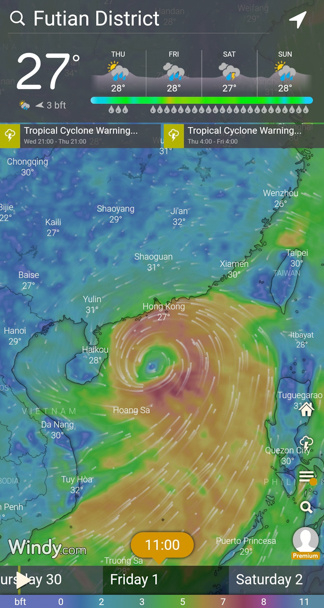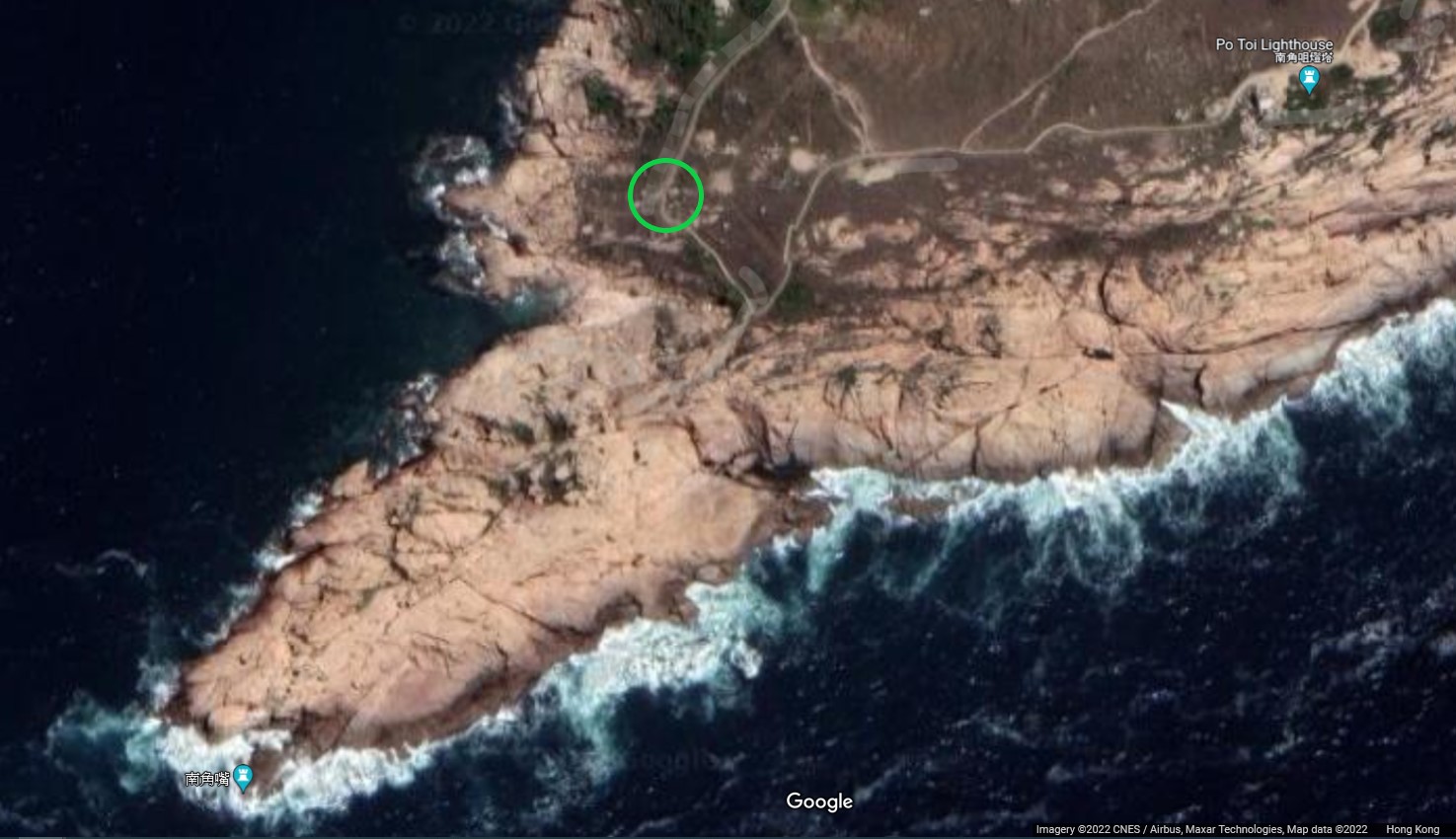1 to 5 July
The majority of the time spent on seawatching during Chaba was thus done in the first five days of July.
1 July was a tough day weather-wise (but more on that in the remarks). The storm signal was raised to T3. Before noon the weather was okay, dry and partly sunny, partly cloudy. All birds were seen during this time. Winds were blowing from the northeast with force 7 to 8. After noon, there were squally showers with very limited visibility and no passing (sea)birds were seen. I watched from 05h50 until 14h45.
Seabirds:
1 juv. Sooty Tern
Gulls:
1 Black-tailed Gull
Terns:
4 Greater Crested Tern
Swift(lets), swallows and martins:
3 Pacific Swifts, plus 1 present
Checklist on eBird:
https://ebird.org/checklist/S114570109
Count on Trektellen:
https://www.trektellen.nl/count/view/3323/20220701
On
2 July, storm signal T8 was in force. It was lowered to T3 in late afternoon. I watched all day, from 06h00 to 17h50. This was the day when Chaba was close and we should get the full impact of it – including birds. The weather was remarkably similar to the previous day, being dry in the first few hours, and rainy with squally showers afterwards. Luckily, there were also a few relatively dry periods, during which birds were usually seen. But very few, and apart from the local terns, (sea)birds. Actually disappointing. Winds were blowing fiercely, with force 8; from east turning to southeast. On Windy, it looked great:

 Seabirds:
Seabirds:
2 Streaked Shearwaters
1 storm petrel spec.
1 Bulwer’s Petrel
1 Brown Booby
Checklist on eBird:
https://ebird.org/checklist/S114570442
Count on Trektellen:
https://www.trektellen.nl/count/view/3323/20220702
On
3 July, the worst of the storm had passed, but bird-wise it was by far the best day of this survey. Storm signal T3 was in force until around 14h00 and winds calmed down a bit to force 6, coming from the south. No more heavy rain but cloudy and dry, even with a bit of sunshine now and then. I seawatched from 06h00 until 17h00.
Seabirds:
1 Short-tailed Shearwater
1 Bulwer’s Petrel
5 Red-footed Boobies
2 Parasitic Jaegers
3 juv. Sooty Terns
Terns:
9 Greater Crested Terns
Checklist on eBird:
https://ebird.org/checklist/S114570776
Count on Trektellen:
https://www.trektellen.nl/count/view/3323/20220703
By
4 July, the storm signals were dropped. Winds were force 6, decreasing to force 5 in the afternoon, and coming from the south to southwest. Weather was good, as it was cloudy but dry. Jaegers, Sooty Tern and boobies passed-by during a very short 15 minutes in the morning; that was it (the phalaropes appeared in the afternoon). I started seawatching at 06h00 and stopped at 16h00.
Seabirds:
2 Red-footed Boobies
2 Parasitic Jaegers
5 Red-necked Phalaropes
1 juv. Sooty Tern
Terns:
12 Greater Crested Terns
Checklist on eBird:
https://ebird.org/checklist/S114578572
Count on Trektellen:
https://www.trektellen.nl/count/view/3323/20220704
And the last day,
5 July, was another very quiet day. Again cloudy and dry, with southwest winds force 5, decreasing to 4. I watched from 06h00 until 12h00.
Seabirds:
1 Brown Booby
Terns:
3 Greater Crested Terns
1 Common Tern
Checklist on eBird:
https://ebird.org/checklist/S114578787
Count on Trektellen:
https://www.trektellen.nl/count/view/3323/20220705
Remarks
We’ll discuss the full storm seawatch survey, from 30 June until 5 July, here.
It certainly was quality, rather than quantity, and there were meagre days. But the full list of (sea)birds was actually not bad, with even some remarkable facts:
2 Streaked Shearwaters
1 Short-tailed Shearwater – A not unusual summer bird, like we saw last year (7 in July).
2 Bulwer’s Petrels – Classic, storm-driven individuals during non-migrating times, I reckon.
1 storm petrel spec. – Idem.
7 Red-footed Boobies – 5 on one day was a new record high count for Hong Kong; single birds from all previous records. During the storm, 3 together were seen off Green Island by other observers, of which at least one (based on shared photos) was in a plumage that was not seen on any of the ones off Po Toi.
3 Brown Boobies – One of them was feeding actively and that's the first time I have seen this species doing that in Hong Kong. 15 BB’s have now been counted from Po Toi this year.
5 Red-necked Phalaropes
5 Parasitic Jaegers – The not unusual summer birds, like we saw last year (9 in July).
1 Black-tailed Gull – 5th summer record for Hong Kong; I’d say this was the most unusual sighting for this survey. This bird should not be here.
5 Sooty Terns – 3 on one day was a new record high count for Hong Kong; the previous peak count was two on 3 August 2016.
39 Greater Crested Terns – Perhaps not a bad count for mid-summer (11 on 30 June and 28 on 1 - 5 July). It seems that they are regular, albeit in small numbers, throughout summer, and numbers increased considerably last year in August (which we count as a summer month in Hong Kong, but is actually an autumn month for migrating birds).
I've made this video of a Red-footed and a Brown Booby:
https://youtu.be/pp7QJQV9I-o
We’ve wondered what could be seen shortly before, during and shortly after a full (T8) storm on Po Toi. Storm seawatching from Cape D’Aguilar has been done regularly in the past. But when you look at a map, you’d agree that Po Toi should be even more promising. This first dedicated, full-time storm seawatch survey illustrates the potential of the waters off Nam Kok Tsui. I reckon a similar storm in August or September might be even much better. There is a good change we might find out in the coming months or years.
One of the main challenges is of course getting to the island before the storm, as ferries will not run as soon as T3 is in force. And then reserve a week or so, because you never know for sure how the storm will evolve and it could take longer than planned to get off the island again.
Previously, my main concern was finding a safe and suitable seawatching spot. A usual spot on the rocks is generally out of the question during a typhoon (T8). It is not only outright dangerous for yourself, but you risk harm to or even loss of your equipment. The steady waves and salt sprays are not the biggest tread, but the unexpected large waves that can catch you by surprise are.
The lighthouse is an option, but I feel it is much too high. For very strong northeast to southeast winds, I did find a suitable alternative near the rocks. Very well protected from even the largest waves, stormy winds, any salt water, and away from the shoreline and on a flat surface.
It is marked with the green circle on this map:


And this is how it looks like, facing the sea:


Is it perfect? No, it’s not. But during a typhoon, you’ll always have to give in on something. You indeed lose about 100 m. to the southeast and almost 200 m. to the southwest. And a part of the rocks obstructs the view. But there is a very large gap to the left of that, where you can see the Lema Channel. And to the right, you can view all of the Hong Kong southern waters. The height is very good. Your tripod and scope are stable. And it’s very safe. Only if winds would turn to the south, you can’t avoid them, unless you give up views of the Lema Channel. (Note: when winds decreased to force 6, coming from the south, I headed back to the rocks and sat on the northwest side, where I could hide from direct winds and waves. I had to regularly bear very fine salt sprays, though.)
Talking about winds, this survey let me experience strong southerly winds. Much more than any other wind I have encountered, these winds truly push seabirds, flying from west to northeast, towards the Nam Kok Tsui peninsula. I could see Red-footed Boobies far away, drifting closer and closer until they passed-by at a range (500 m. or perhaps even closer) which I never encountered before. Also, Short-tailed Shearwater, Parasitic Jaegers, Sooty Terns and Greater Crested Terns passed-by unusually close. The Bulwer’s Petrels were one of the few seabirds that were not pushed towards the peninsula.
However, I struggled to get good photos, even tough there was plenty of opportunity. A reason was that I often sat behind a rock and birds would disappear behind that a bit too soon to get them on camera. And another reason is that my camera was almost all the time in my backpack, covered with a backpack cover and put in a plastic bag, as the lens is not waterproof. There was always a chance for rain or salt sprays. Unpacking it would simply take too much time. Another point to improve upon, as a ‘LensCoat RainCoat’ (
https://www.lenscoat.com/raincoats-raincaps-c-34.html) should come to the rescue next time.
Speaking of rain. Lengthy (two to three hours) of almost continues heavy showers with squalls is part of every typhoon. I’ve learned that there is not much choice than to just sit through them. There is nothing to see, as visibility becomes very limited (<500 m.). Birds might appear ones the rain stops – and you have to be there at that moment –, and some less rainy periods in between can produce something as well. But I’d say: no pain, no gain, and no typhoon without rain. ;-)
We learned a lot, made some mistakes and did some things wrong, so there will be plenty to improve on during our next storm seawatch survey.
[
Last edited by badesc at 21/07/2022 16:10 ]


